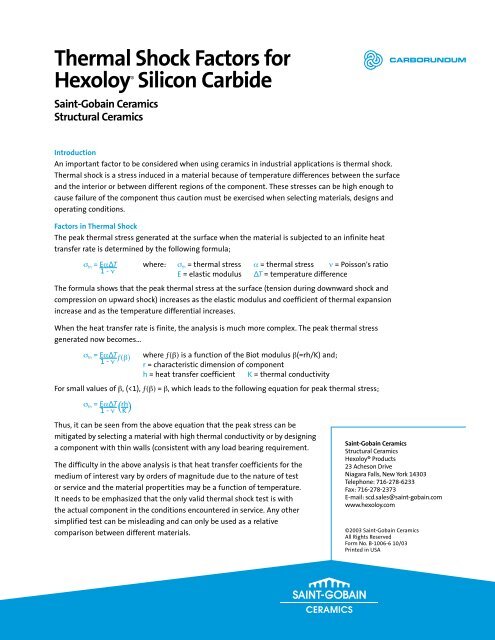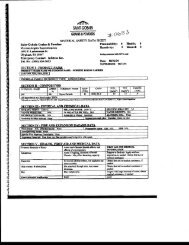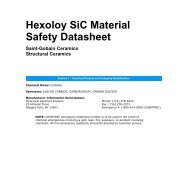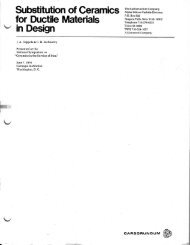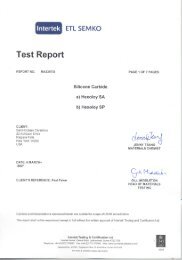Technical Data Sheet Form No. B-1006-6 - Hexoloy
Technical Data Sheet Form No. B-1006-6 - Hexoloy
Technical Data Sheet Form No. B-1006-6 - Hexoloy
You also want an ePaper? Increase the reach of your titles
YUMPU automatically turns print PDFs into web optimized ePapers that Google loves.
Thermal Shock Factors for<br />
<strong>Hexoloy</strong> ® Silicon Carbide<br />
Saint-Gobain Ceramics<br />
Structural Ceramics<br />
Introduction<br />
An important factor to be considered when using ceramics in industrial applications is thermal shock.<br />
Thermal shock is a stress induced in a material because of temperature differences between the surface<br />
and the interior or between different regions of the component. These stresses can be high enough to<br />
cause failure of the component thus caution must be exercised when selecting materials, designs and<br />
operating conditions.<br />
Factors in Thermal Shock<br />
The peak thermal stress generated at the surface when the material is subjected to an infinite heat<br />
transfer rate is determined by the following formula;<br />
σ th = Eα∆T where: σ th = thermal stress α = thermal stress ν = Poisson's ratio<br />
1 - ν<br />
E = elastic modulus ∆T = temperature difference<br />
The formula shows that the peak thermal stress at the surface (tension during downward shock and<br />
compression on upward shock) increases as the elastic modulus and coefficient of thermal expansion<br />
increase and as the temperature differential increases.<br />
When the heat transfer rate is finite, the analysis is much more complex. The peak thermal stress<br />
generated now becomes…<br />
σ th = Eα∆T ƒ(β)<br />
1 - ν<br />
where ƒ(β) is a function of the Biot modulus β(=rh/K) and;<br />
r = characteristic dimension of component<br />
h = heat transfer coefficient K = thermal conductivity<br />
For small values of β, (
Recommendations for <strong>Hexoloy</strong>® SiC<br />
• Using data from the <strong>Hexoloy</strong>® product brochure, a design engineer can calculate the stress generated<br />
by application temperature differentials. An example is shown at the bottom of the page.<br />
• Designs for potential high temperature differential applications should incorporate thin and uniform<br />
walls. To reduce additioal stress concentrators, transitions and undercuts should be radiussed while all<br />
edges should be chamfered to avoid chipping.<br />
• Our testing has also shown that finished grinding may induce additional stresses affecting thermal<br />
shock performance. Extreme applications may call for annealing ground components.<br />
Conclusion<br />
Design engineers can effectively use the best properties of silicon carbide, excellent corrosion and erosion<br />
resistance coupled with high thermal conductivity, in their application by balancing key parameters.<br />
Thermal Shock<br />
example: σ th = Eα∆T<br />
1 - ν<br />
for <strong>Hexoloy</strong>® @ application ∆T = 225˚C (437˚F)<br />
where: σ th = thermal stress<br />
E = elastic modulus<br />
= 59 x 10 6 psi<br />
α = coefficient of thermal expansion = 2.2 x 10 -6 in/in ˚F<br />
∆T = temperature difference<br />
= 437˚<br />
ν = Poisson's ratio = 0.14<br />
or<br />
σ th = 66 x 10 3 psi<br />
= 445 MPa<br />
Saint-Gobain Ceramics<br />
Structural Ceramics<br />
<strong>Hexoloy</strong>® Products<br />
23 Acheson Drive<br />
Niagara Falls, New York 14303<br />
Telephone: 716-278-6233<br />
Fax: 716-278-2373<br />
E-mail: scd.sales@saint-gobain.com<br />
www.hexoloy.com<br />
©2003 Saint-Gobain Ceramics<br />
All Rights Reserved<br />
<strong>Form</strong> <strong>No</strong>. B-<strong>1006</strong>-6 10/03<br />
Printed in USA<br />
The information recommendations, and opinions set forth herein are offered solely for your consideration,<br />
inquiry and verification and are not, in part or total, to be construed as constituting a warranty or representation<br />
for which we assume legal responsibility. <strong>No</strong>thing contained herein is to be interpreted as authorization<br />
to practice a patented invention without a license.<br />
<strong>Hexoloy</strong>® is a trademark of Saint-Gobain Ceramics.


